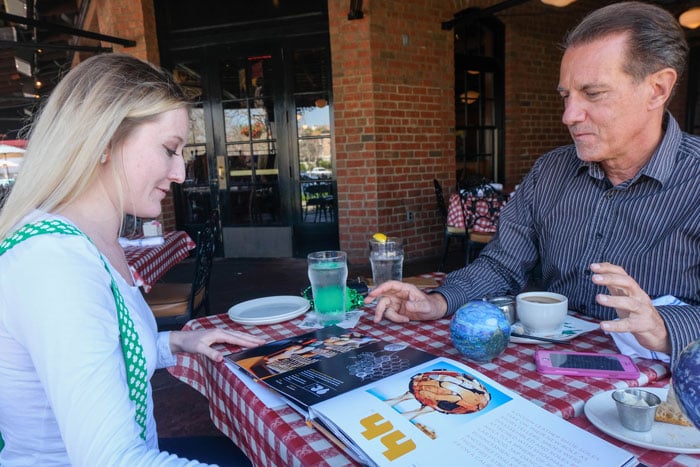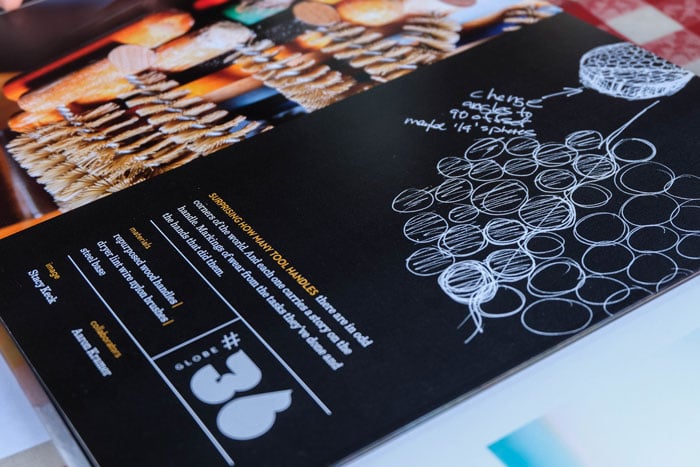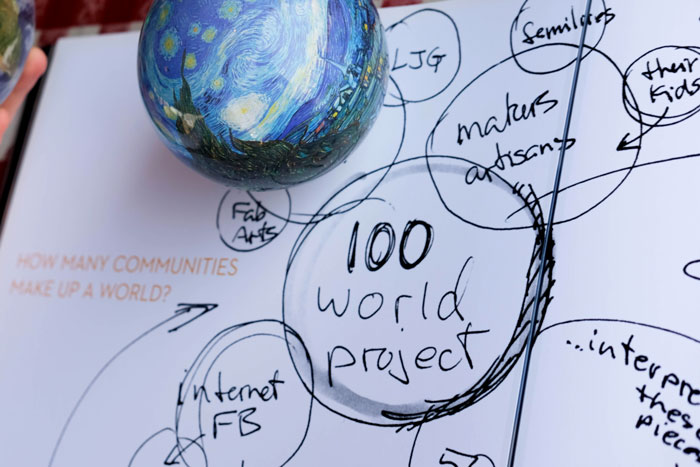Globes as Community Builders: A Lunch with Ron Miriello
“The best thing about a globe is that it’s an entry point for everybody. Everybody plays in that world… it’s a community-building tool.” – Ron Miriello
Working at MOVA, we’ve developed a habit — or perhaps a calling — to notice globes wherever we go. So, when we came across the 100 Worlds Project, we were immediately intrigued. This remarkable initiative, created by San Diego-based artist and designer Ron Miriello, reimagines the globe as a sculptural art form using the most unexpected materials — from pencils and book pages to shoe soles and steel cables.
When we discovered Ron lived locally, we reached out, and he graciously invited me and my colleague Tori to join him for lunch at a relaxed seafood spot in San Diego. What followed was a fascinating conversation about globes, creativity, and the power of collaboration.

Ron walks us through his 100 Worlds Project book and points out the different globes and their materials and makers.
Rediscovering the World Through Art
Initially, we felt a little daunted to meet someone of Ron’s creative calibre. But once we settled in, our chat flowed easily. Over stories about summers in Italy and musings about the Galileo Museum in Florence, we found ourselves bonding over our shared appreciation for craft, curiosity, and of course — globes.
Ron shared his thoughts on the loss of traditional craft in an age of automation. It struck a chord with us, especially since MOVA Globes are still hand-assembled, involving intricate craftsmanship and patented design.
What made our meeting so meaningful was Ron’s idea of the globe not just as an object, but as a canvas for collaboration and curiosity.
Inside the 100 Worlds Project
We dove into Ron’s 100 Worlds Project, a collection of sculptural globes, each crafted from unique, often unconventional materials. It was clear this wasn’t just about design — it was about shifting perspectives.
“I love taking things people think they already know and don’t really look at... Getting people to pause and see it in a new way — that’s the artistic part.” – Ron Miriello

Despite its name, the 100 Worlds Project consists of 50 globes (so far). Ron explained that he always intended for others to help complete the remaining 50 — to take the idea further and make it their own. “I wanted to facilitate a community,” he said, “not just have people say ‘Wow, Ron is really creative’.”
Creative Collaboration at the Core
Ron worked closely with artisans, designers, welders, and photographers to bring each globe to life. One globe — World #42 — was made of sharpened pencils his mother had once used. She was credited as the globe’s maker. Another was co-created with a welder whose young son later told him, “Dad, you’re an artist!” These stories reflect Ron’s desire to break down the barriers between professional artists and everyday creators.
He even included a 9-year-old’s sketches in his gallery show, naming it “Zach’s Gallery” and awarding him a plaque. These acts of inclusion are what transform the 100 Worlds Project into more than an art exhibition — they turn it into a creative movement.
Each globe was also photographed by a different photographer. Given minimal guidance, each brought their own perspective, effectively becoming co-creators themselves. By the time the project debuted, it had become a true community effort — a network of over 100 contributors.
Ron’s book depicts a network showing all the people who were involved in the project, which at the time of completion became more of a family and community.
Kindred Spirits and Shared Missions
During lunch, Ron offered fresh ideas for our MOVA Globes — from sculptural bases to expanded creative collaborations. We couldn’t help but feel we were kindred spirits in the world of globes, each using them to tell stories and spark wonder in our own ways.
“When people say, ‘Oh I want a globe that looks like this’ – that’s when you know they’re in the game,” said Ron.
As lunch came to an end, we realised this wasn’t just a discussion about globes — it was a discussion about human connection, shared creativity, and what happens when you invite others into your artistic process.
What’s Next?
Ron is now developing a community bike centre in San Diego’s Liberty Station, proving once again that his passion lies not in being labelled an “artist,” but in building spaces where creativity can thrive and connect people.
The 100 Worlds Project reminds us that globes, much like the Earth they represent, have the power to bring people together — across disciplines, generations, and geographies. Whether made from pencils, paper, or pixels, globes are symbols of possibility.
We left the lunch inspired and even more motivated to explore how MOVA Globes could evolve in unexpected ways.



